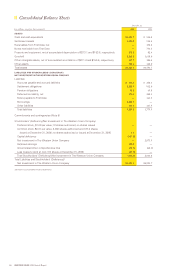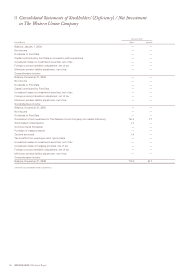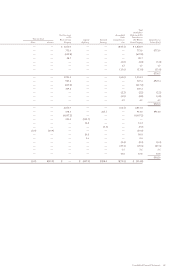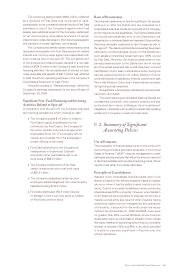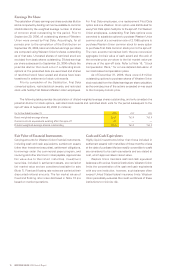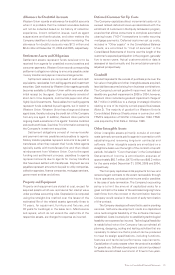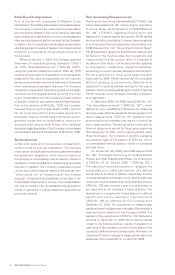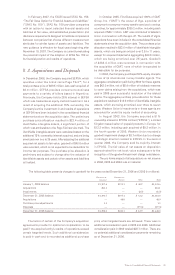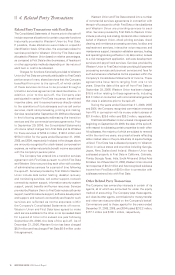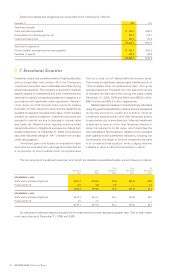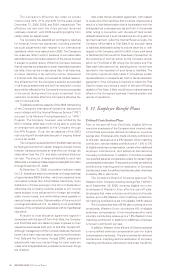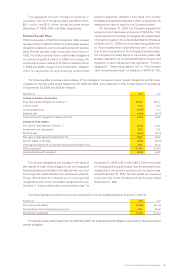Western Union 2006 Annual Report Download - page 75
Download and view the complete annual report
Please find page 75 of the 2006 Western Union annual report below. You can navigate through the pages in the report by either clicking on the pages listed below, or by using the keyword search tool below to find specific information within the annual report. Notes to Consolidated Financial Statements 73
Advertising Costs
Advertising costs are charged to operating expenses as
incurred or at the time the advertising first takes place.
Advertising costs for the years ended December 31, 2006,
2005 and 2004 were $261.4 million, $243.3 million and
$227.9 million, respectively.
Income Taxes
Prior to September 29, 2006, Western Union’s taxable
income was included in the consolidated U.S. federal
income tax return of First Data and also in a number
of state income tax returns, which are or will be filed
as consolidated returns. Western Union files its own
separate tax returns in foreign jurisdictions, and for
periods subsequent to September 29, 2006, files its own
U.S. federal and state income tax returns. Western Union’s
provision for income taxes has been computed as if it were
a separate tax-paying entity for periods prior to the spin-
off from First Data, and federal and state income taxes
payable were remitted to First Data prior to the spin-off.
The state and other income tax provisions represent
applicable taxes payable to the various jurisdictions in which
Western Union operates. Foreign taxes are paid in each
respective jurisdiction locally.
Western Union accounts for income taxes under the
liability method, which requires that deferred tax assets
and liabilities be determined based on the expected future
income tax consequences of events that have been
recognized in the consolidated financial statements.
Deferred tax assets and liabilities are recognized based
on temporary differences between the financial statement
carrying amounts and tax bases of assets and liabilities
using enacted tax rates in effect in the years in which the
temporary differences are expected to reverse.
Foreign Currency Translation
The U.S. dollar is the functional currency for all of Western
Union’s businesses except certain investments located
primarily in the United Kingdom, Ireland and Argentina.
Foreign currency denominated assets and liabilities for
those entities for which the local currency is the functional
currency are translated into U.S. dollars based on exchange
rates prevailing at the end of the period. Revenues and
expenses are translated at average exchange rates prevailing
during the period. The effects of foreign exchange gains
and losses arising from the translation of assets and
liabilities of those entities where the functional currency
is not the U.S. dollar are included as a component of
“Accumulated other comprehensive loss”. Foreign currency
translation gains and losses on assets and liabilities of
foreign operations in which the U.S. dollar is the functional
currency are recognized in operations.
Derivative Financial Instruments
Western Union utilizes derivative instruments to mitigate
foreign currency and interest rate risk. The Company
recognizes all derivative instruments in the “Other assets”
and “Other liabilities” captions in the accompanying
Consolidated Balance Sheets at their fair value. Changes
in the fair value of derivatives, which are designated and
qualify as cash flow hedges in accordance with Statement
of Financial Accounting Standards (“SFAS”) No. 133,
“Accounting for Derivative Instruments and Hedging
Activities,” as amended and interpreted (“SFAS No. 133”),
are recorded in “Accumulated other comprehensive loss”
and reclassified into revenue or interest expense, for foreign
currency and debt related hedges, respectively, in the same
period or periods the hedged item affects earnings, to the
extent the change in the fair value of the instrument is
effective in offsetting the change in fair value of the hedged
item. The portion of the change in fair value that is either
considered ineffective or is excluded from the measure of
effectiveness is recognized immediately in “Derivative
(losses)/gains, net.” Derivative contracts entered into to
reduce the variability related to settlement assets and
obligations, generally with a term of one to three weeks,
are not designated as hedges for accounting purposes
and, as such, changes in their fair value are included in
operating expenses consistent with foreign exchange rate
fluctuations on the related settlement assets and obligations.
All cash flows associated with derivatives are included in
cash flows from operating activities in the Consolidated
Statements of Cash Flows other than those previously
designated as cash flow hedges that were determined to
not qualify for hedge accounting as described in Note 14.
The Company also had certain other foreign
currency swap arrangements with First Data, prior to
September 29, 2006, to mitigate the foreign exchange
impact on certain euro denominated notes receivable with
First Data. These foreign currency swaps did not qualify
for hedge accounting and, accordingly, the fair value changes
of these agreements were reported in the accompanying
Consolidated Statements of Income as “Foreign exchange
effect on notes receivable from First Data, net.” The fair
value of these swaps were recorded in “Receivables from
First Data, net” in the accompanying Consolidated Balance
Sheets and were settled in cash along with the related
notes receivable in connection with the spin-off.
The estimated fair value of the Company’s derivative
financial instruments is based on market and dealer
quotations. Accordingly, these estimated values may not
be representative of actual values that could have been
realized as of December 31, 2006 or 2005 or that will be
realized in the future.



